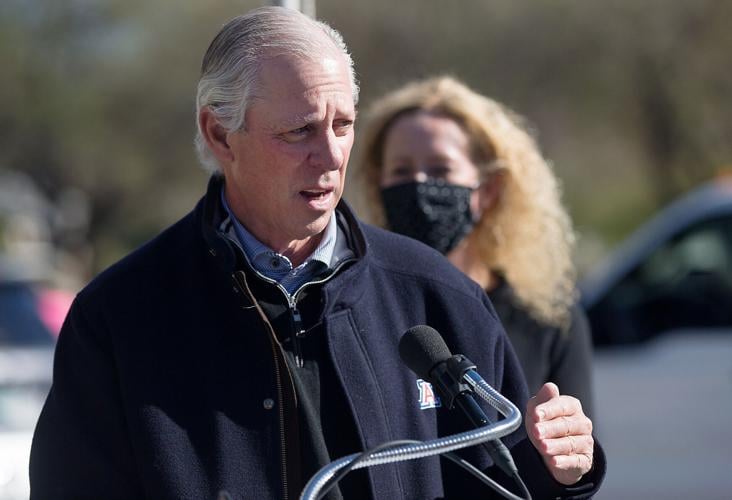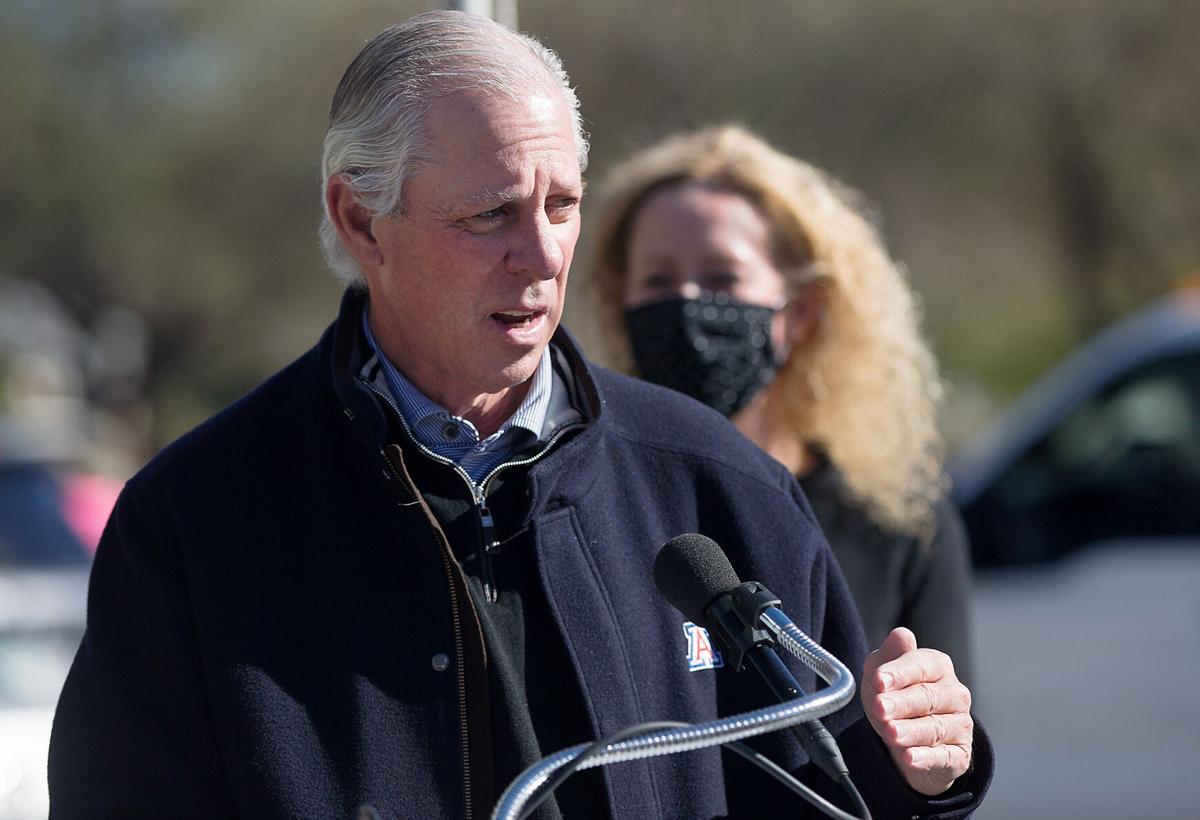When University of Arizona President Robert Robbins announced the institution is in a “financial crisis,” faculty were shocked.
Now that their initial surprise has worn off, many are hitting back against the university president, claiming the turmoil is not a financial crisis, but instead a management one.
“We have a long history of concerns about lack of transparency, lack of accountability and management problems at the University of Arizona,” said chair of the faculty and anthropology professor Leila Hudson. “But even I was not prepared for the scope, scale and suddenness of this management crisis.”
At the Arizona Board of Regents’ Nov. 2 meeting, Robbins and Lisa Rulney, UA senior vice president for business affairs and chief financial officer, admitted to a financial miscalculation that left the university much more fiscally vulnerable than they originally predicted. Administrators originally believed they had 156 days’ worth of cash on hand, but are now projecting only 97 for this fiscal year. That’s a miscalculation of $240 million.
The UA is now significantly lagging behind the regents’ requirement of at least 140 days cash on hand. Arizona State University currently has 171 days cash on hand while Northern Arizona University has 180, according to board documents.

Lisa Rulney
UA faculty members who spoke both on and off the record to the Arizona Daily Star claim that a series of financial moves, including acquiring the online Ashford University (now known as the University of Arizona Global Campus), and loaning the university’s athletic department more than $50 million during the COVID-19 pandemic that has yet to be repaid show mismanagement from Robbins and his central administration.
“In an institution of this size and this scale and this importance to the life of our state and the people of Arizona, we need the very highest level of professional management,” Hudson said. “I do not have confidence that we currently have that.”
UA officials did not respond to multiple questions and comment requests from the Arizona Daily Star submitted to UA spokeswoman Pam Scott in the last week.
In both his statement to the Board of Regents and in a Faculty Senate meeting Monday, Robbins blamed the financial situation on overspending in athletics and financial aid. He said the university is considering cutting some sports programs and lessening the amount of financial aid given to students. There will also be a 2% budget cut put in place.
But some faculty members aren’t buying Robbins’ proposals.
They point to information shared by the university in a nearly 400-page document produced by the Board of Regents, which states that “the acquisition of UAGC added $265.5 million in operating costs, thus increasing the denominator in the days cash formula.”
This statement, Hudson believes, shows that the purchase of UA Global Campus has had a much larger impact on the university’s cash reserves than officials are letting on.
“It seems to me that they’re trying to obscure the role of UAGC in this,” Hudson said. Robbins did not mention UAGC in his statements to ABOR or in the Faculty Senate meeting he attended earlier this week.
“The costs and risks of the UAGC deal continue to manifest themselves in ways that the administration and the Board of Regents resolutely refused to see even when we predicted them over the last three years,” Hudson said.
Despite the ABOR report stating that UAGC was a reason for the lower cash on hand, the statement continues to say that “the current budget model is designed to support investment in high revenue growth and high margin potential areas, such as University of Arizona Global Campus.”
The university acquired Ashford University in 2020 and began the process of integrating it into its UA Global Campus earlier this year, despite faculty going on the record against the project.
In August, the Biden administration cancelled $72 million in student loans for borrowers who say they were cheated by Ashford University. The U.S. Department of Education is seeking to recoup the money from the UA, which is claiming it should not be held responsible because the actions occurred well before it acquired the school. If it is held responsible, the UA will face even more of a challenge in its efforts to rebuild its central reserve funding.
The handling of the UAGC deal is not the only qualm the faculty have. Many are disgruntled with the way the money they bring into the university is managed. According to Gary Rhoades, an education professor, the colleges actually made the university $79.4 million this past year.
“Basically, they took our money and went out and bought an expensive car,” Rhodes said. “The big problem with (our) budgeting system is that there’s no internal regulations on central administration’s spending.”
The problem is not the colleges, which have been generating a net surplus, Rhoades said. It’s that “the central administration is spending money in an undisciplined way.”
Rhoades said that rather than spending some of the central reserve on bailing out the athletic department, Robbins and senior leadership should have put more resources towards hiring tenure track faculty. Currently, only 10% of new hires are tenure track, a statistic that Rhoades said even Robbins was surprised by when he told him about it.
“That’s not the profile you need for a research university,” Rhoades said. “You cannot have a research university without tenured faculty. It just doesn’t work.”
Ted Downing, a research professor who has been at the UA for more than five decades, said he finds the situation to be “embarrassing” for the university.
He is especially angry that the UA spent so much of its central reserves on the athletic department. During the pandemic, Downing said, faculty and staff were asked to take furloughs, which helped make the university about $45 million. The athletic department accepted a loan of $55 million from the university’s general operating budget with no way of paying it back, he said.
“Some people had trouble paying their mortgages and car payments, especially the staff,” he said. “What kind of a role model is the athletic department setting for the public and the students who are taking out student loans by refusing to repay their loans?”
The clock is ticking, Downing said, and the university “is in crisis.” Robbins has until Dec. 15 to submit his plan to ABOR.
One of the key parts of Robbins’ plan seems to be instituting a hiring freeze, something he mentioned both at the ABOR meeting and at the Faculty Senate meeting. Downing, Hudson and other professors are hoping that he cuts some senior staff positions to reduce “administrative bloat” instead.
The business affairs staff, which is responsible for calculating the days cash on hand, has 28 employees. Rulney, who many faculty blame for the financial mismanagement, has a staff of seven that report to her alone.
“Let’s start by reducing administrative salaries,” said Katie Zeiders, a family services professor. Zeiders spoke on behalf of the United Campus Workers Arizona union. “It’s time for senior administrators to truly take responsibility for this.”
Zeiders pointed to the severe pay discrepancies between senior staff and faculty.
She cited writing professors who make $44,000 a year in comparison to Rulney who, according to public records, makes just under $500,000 per year.
“These faculty members are teaching the basics of writing in college to 100 students a semester,” she said. “Rulney makes ten times that amount.”
Robbins makes just under $1 million per year, according to public records. The two highest paid employees at the UA are head basketball coach Tommy Lloyd, who makes $3.6 million per year, and head football coach Jedd Fisch, who makes $2.1 million per year.
In comparison, Zeiders said, custodial staff make an average of $28,000 and dining services workers make an average of $21,000 a year.
The pay difference is gaining attention especially in light of Robbins’ statements to both ABOR and the faculty that the athletic department as a whole is not making the money it needs to financially sustain itself.
Downing said he was “disgusted” by the pay discrepancies.
“The role model we’re getting is a president who doesn’t want to pay his bills and a set of multi-million dollar paid coaches and an athletic director saying ‘we’re not going to pay our bills,’” he said. “That makes no sense. It’s called a deadbeat role model. That is not what we need right now.”
At the University of Arizona Faculty Senate meeting on Feb. 6, 2023, UA President takes "full responsibility" for campus safety breakdown before Meixner shooting.






